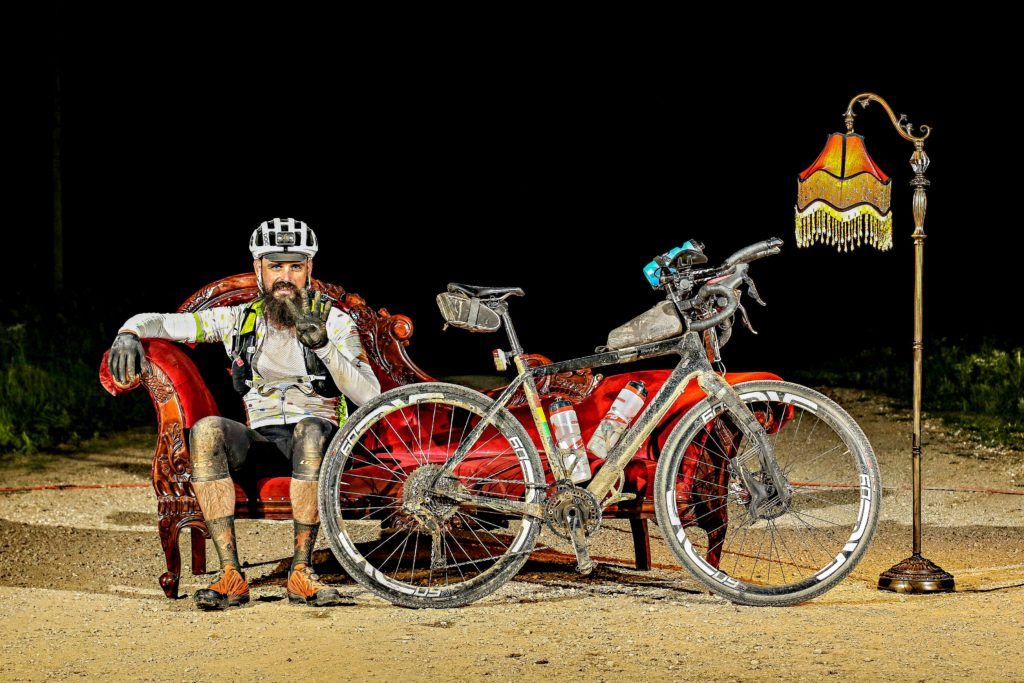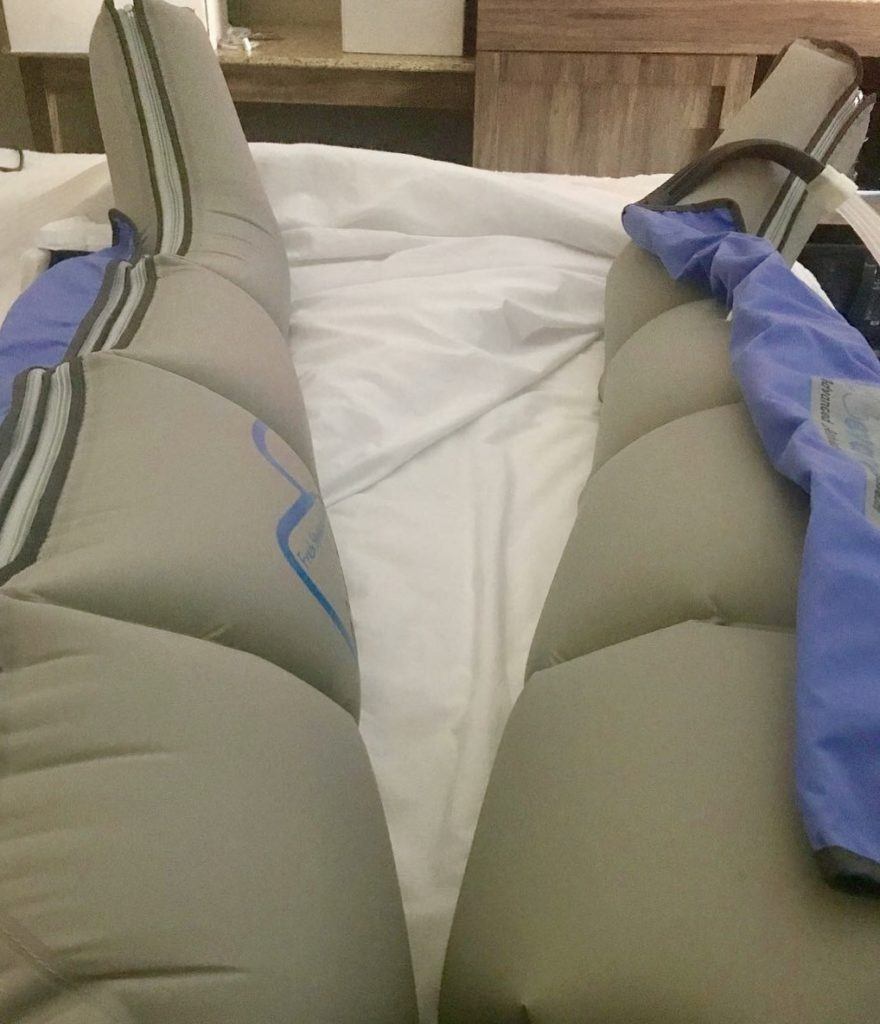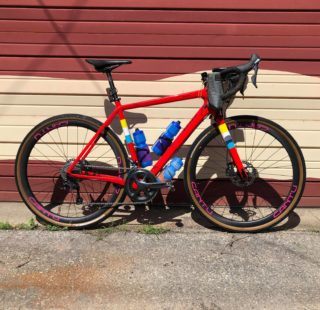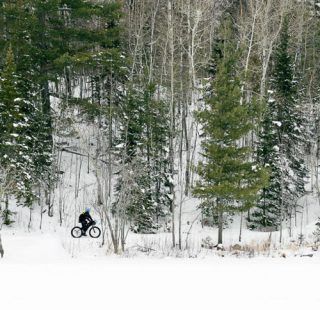ADVNTR caught David Markman before the start of his 4th Dirty Kanza for a bike check and insight into his strategy plans. Now the dust has settled (and finally washed out of the cycling kit), we thought we’d give him a shout and see how it went.
You planned to do 5 DK200s to complete a 1,000 mile challenge, with 800 under your belt are you still eager to race the Dirty Kanza again?
After my first DK200 in 2015 I was done. I did my one and was happy to move on to other events. 2016 I did Tour Divide and to warm up the legs days before, I raced the Dirty Kanza 200 again… So now I had 2 finishes and the Gravel Grail was maybe something I wanted to chase.
For 2017 I was looking to beat the sun because I missed it the year before by 15 or so minutes and conditions were amazing so I checked that one off, now I had more finishes than not so I was committed to finishing 5. This year was a chill year. I didn’t have a goal other than to finish and enjoy the journey and with the weather it was looking like a good year for that. Now with 4 finishes under my belt, I’ll be going back for number 5 next year and if it all falls into place I’ll have my Gravel Grail!

Four times a DK200 rider! Photo credit: scottharaldson.com
Did you prepare differently for this year’s event based on your prior experiences? (knowing you have only ridden a bit this year!)
Prepare? I didn’t prepare at all! I started a new business this February and it has been taking all my spare time to get it off the ground, so I didn’t ride much leading up to the Dirty Kanza 200. This was my 4th year so I knew what to expect so how hard could it really be, right? Well it dished out a brutal race in typical DK200 fashion and I regretted not putting more miles in before the race.

Tell us how your race panned out, any notable events?
The morning started with crazy strong winds like 50-60 MPH gusts. I woke up to hear the patio chairs outside of my hotel sliding across the parking lot and stepping outside, my bike became a kite as I turned it into the wind to load it on my car. Arriving at the starting line we found out there was going to be a 30-minute lightning storm delay so I caught some more sleep.
I knew I could race the sun again this year if I played all my cards right and everything fell into place, but it was going to be a very tough day. The first leg of the race is my favourite, it is so beautiful and fast and I came into CP1 on schedule in just over 3 hours. After leaving CP1 I knew I didn’t eat enough to maintain that pace but still tried to dig deep to make it to CP2, but at mile 94 I came across a tandem that had crashed and both the captain and stoker were in really bad shape. There was a lot of blood and the stoker was in and out of consciousness, one other person had stopped just before me, then another and another. Together we cleared the road of bikes and debris, got traffic to slow down as it was on the back side of a blind downhill, and called EMS and the race directors, then waited for EMS life flights to arrive. Once I knew they were in good hands I jumped back on my bike and made my way to CP2.
Now having lost a big chunk of time my plan to race the sun was out the window, which was fine. The true test is what someone will do when their plan falls through, do you sit down and give up or do you push forward and make a new plan? Endurance racing is the latter, when the conditions get tough or you are not performing how you expected you need to keep pushing, that will set you apart from the rest of the field.
The third leg is my least favourite as it is always hot and windy with little shade available, this year was no different. It proved to be just as brutal and difficult as always and I was happy to pull into CP3 still in daylight. At this point I was suffering from heat stroke and dehydration and my stomach wasn’t happy with me, but I knew I only had 44 miles to the finish and somewhere out there I’d find the chaise longue. Everything was good as I rode into the darkness until 26 miles from the finish. I cut my side wall on a large rock I should have avoided but in my sleepy state could not react fast enough. Having fixed that I found the chaise lounge, got my photo, and finished the last 25 miles. I had no real expectations for this year’s Dirty Kanza 200 other than to finish and this was the hardest DK200 I have done yet, and yes harder than the 2015 mud year.

Your kit choices should be tried and tested now, did all your kit perform as expected?
Yeah a 200-mile event is not the time to try out new gear, and being a veteran to the sport I have compiled a well-rounded assortment of gear that has worked well for me in the past and I can rely on. Some things I did change were to use large tubes of GU rather than individual packets in hopes of eliminating extra trash, these unfortunately didn’t work well on the gravel as they did on training rides. They would work great for prepubescent men or non-bearded women. I found that the twist closure would catch my moustache and then rip it out so I only used them once while riding. The other new thing I tried was a different hydration pack this year. I used a running pack from Osprey and really liked how it distributed the weight and was very stable on rough roads. If you follow me on Instagram (@bikepackingdavid ) you will see gear related tips for Dirty Kanza and things I have picked up along the way to help survive these long events.

They say every day is a school day, what did you learn on this outing?
You are always learning that is true, and I enjoy endurance events like Dirty Kanza 200 because you can make mistakes, and still make it to the finish with your support crew help. The morning started with crazy wind like 50 MPH gusts as a storm was rolling through and it was cold-so I put on a light weight rain jacket thinking I’d be wet and cold at the start. That was great for the first 15 or so miles but then the sun came out and it got hot, I started to sweat more than I should have at that point but didn’t want to stop as I was holding on to a wheel and making good time. That eventually led to dehydration and combined with the heat later in the day heat stroke, which can be very serious.
I also learned that 200 miles of training for the year is not enough miles to ride before the Dirty Kanza 200. Being my 4th year I knew what to expect but it wasn’t much fun. I forgot how punchy those climbs can be. After stopping for that tandem, my plan when out the window to beat the sun, so I just kept moving but took time to chat with fellow riders on course and smell the roses so to speak, that country is beautiful and during the race you see so little of it because your head is down.
The elevated legs recovery system looks fascinating, talk us through how it helped…
Yeah they are the bee’s knees, after any hard workout your muscles develop sports waste, lactic acid and such. Getting all that out will speed up your recovery time so you can push hard again the next day or at least walk normally. After an event like Dirty Kanza 200 it will take multiple sessions to flush out sports waste, combined with foam rollers and massage. Typically, I’ll throw them on and watch TV while eating a meal because as you can imagine the days after a 200 mile race I’m always hungry.

The elevated legs system
To see more of David’s own adventures you can follow him on Instagram @bikepackingdavid or check out some amazing photos at https://markmanoutdoorphotography.com/
Last modified: 26th June 2018










